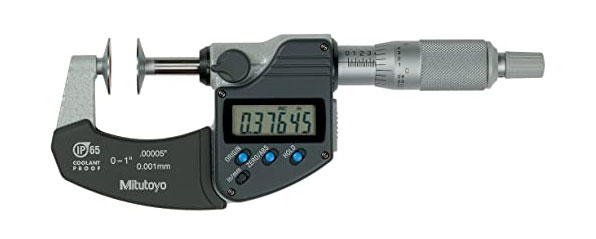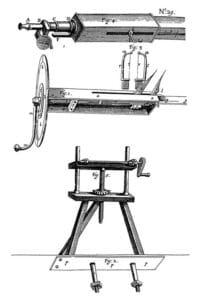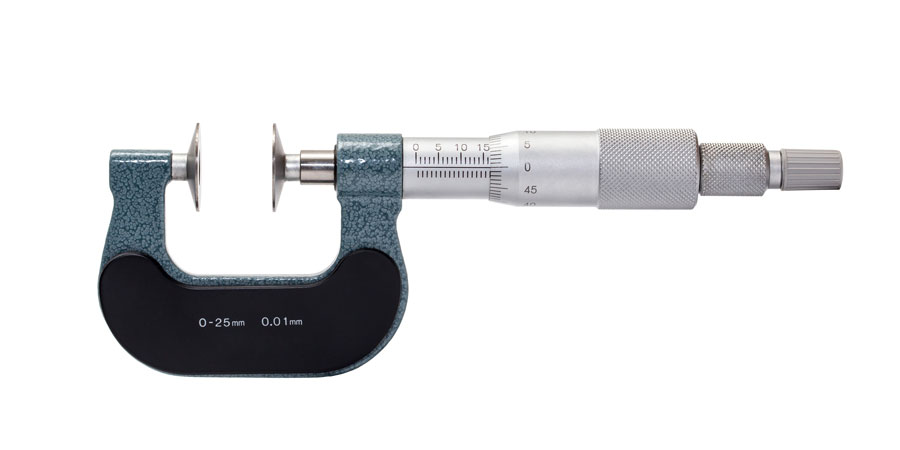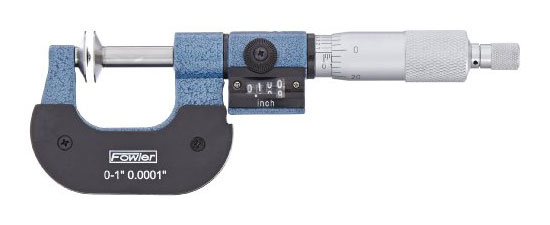Just when you thought that micrometers could not provide more interesting material to the field of metrology to talk about, out comes the disk micrometer. Disk micrometers might be the lesser known cousin to the standard micrometer we all know and love, but disk micrometers come with their own set of advantages and uses. Today, the Higher Precision team would like to show you a bit about the world of disk micrometers and how they might improve your measurement abilities.
The Basics of Disk Micrometers

The disk portion of disk micrometer is referring to the shape of the measurement faces that sit on the ends of the anvil and the spindle. In the case of the disk micrometer, these measuring faces are in the shape of a disk, creating a flat, open, plate-like surface with which to measure. The disk micrometer can be used when taking measurements of all sorts of shaped parts, such as ribs, lands, fins, cutting edges, or gear teeth. The shape of the spindle faces also allows for accurate measurement of sheet materials.
Common Uses for Disk Micrometers
The disk micrometer is famous for taking the measurement of the root tangent length of gears that may be shaped as a spur or in a helical structure. The reason that disk micrometers are ideal for this measurement context is their ability to slide into narrow curves while resting flat across the wideness of the gear extension. Similarly, disk micrometers are well-suited to measuring features of a part that are recessed or just difficult to reach in some way. These types of measurements are not as easily completed with a standard micrometer or other typically shaped measurement faces such as bore, tube, or ball micrometer faces. Another common use for the disk micrometer is to collect measurement of easily deformed or fragile work materials like rubber sheets, paper sheets, or film.
A Brief History of the Micrometer and the Disk Micrometer
In 1638, the astronomer W. Gascoigne began to use threads to measure the distance between stars, thus leading him to invent the caliper micrometer gage. In this early invention, a disc was used as a reference point for counting revolutions to determine measurement. In the 18th century, the steam engineer James Watt invented the first bench micrometer. This tool also used a pair of graduated discs in order to determine the movement of threads that represented distance based on disc revolutions. Since these early times, discs have continued to play an important role in measurement using micrometers, with updated encoder technology becoming the norm. The disk micrometer takes the unique shape of the disc and applies to a more active role in the measurement process beyond the translation of revolutions. By utilizing the disc shape as the measurement faces of a micrometer, the disk micrometer is well-suited to accomplish precise measurements under otherwise precarious circumstances.

Gascoigne’s Micrometer as drawn by Robert Hooke
Major Advantages of Disk Micrometers
So, why is the disk micrometer so good when taking measurements in these contexts? The disk micrometer can handle measurement scenarios that other micrometers are not cut out for. Because the shape of the measurement face is thin, wide, and even, disk micrometers have improved reaching abilities that other micrometers do not. It is the plate-like shape on the measurement faces that allows hard to reach spaces to be no problem with the disk micrometer. Navigating gear teeth is made into a simple task with the disk micrometer. Additionally, the design of the disk micrometer creates an evenly applied forces across the whole surface of the measurement. This is particularly useful when taking measurements of more delicate or easily warped materials like thin rubber, paper, film, plastics, or even foam. The disk micrometer spreads out the force being applied to complete the measurement in an even manner, thus minimizing potential damage that could occur. Finally, disk micrometers come in very useful when working with materials that may be too thick for a standard micrometer. For example, when measuring a thick sheet metal, the disk micrometer measurement faces are able to be extended wide enough while still fitting over the surface that needs to be measured due to their thin but wide design.
Parallelism and the Disk Micrometer
The disk micrometer is particularly suited for taking the measurement of widths that involve narrow clearances. Since the large disc-shaped flats extend beyond the spindle and anvil, parallelism errors are potentially more of a risk. Parallelism refers to the condition of a surface, line, or axis which is determined to be equidistant at all from a datum plan or axis. Parallelism is distinct from flatness, which is the condition of a surface which is determined to have all elements in one plane. Due to the important factor of parallelism, checking for parallelism error in the contact points can be an important step in attaining precision when using a disk micrometer. Checking the parallelism may be accomplished by using a precision ball across a few locations between the two contact faces. If you should find a discrepancy that is greater than a single grade of the Vernier scale, this could suggest required correction of the anvil and spindle to eliminate potential parallelism error.
Conclusion
The disk micrometer is greatly suited for measuring across great distances, such as thread wires. The unique flat and wide shape of the anvil and spindle on a disk micrometer allow these measurement faces to fit over surfaces where other micrometers are unable to do so. Many disk micrometers today may come with both a manual and digital readout, allowing for precise data collection. Having a disk micrometer on hand is a great way for you to improve your precision measurement repertoire. Contact Higher Precision today if you would like to hear more about the disk micrometers we sell and what they can accomplish.
FREQUENTLY ASKED QUESTIONS
- What is a disk micrometer?
A disk micrometer is a particular type of micrometer that has two disc-like shaped measurement faces attached to the anvil and the spindle. The disk micrometer is used to measurement lengths and thicknesses of various parts and surfaces. Due to the wide, flat, even nature of the measurement faces, the disk micrometer is particularly well suited to completing measurements of unusually shaped parts. Making tough to reach spaces and thinner materials a breeze to measure, the disk micrometer is commonly used with ribs, lands, finds, cutting edges, gear teeth, paper, rubber, plastic, metals, and foam.
- What is a disk micrometer used for?
Disk micrometers are used across a variety of measurement contexts, often in circumstances when other micrometer designs are not appropriate. Perhaps the most common use of the disk micrometer is to determine the root tangent length of a gear or helical part. The thin, but wide discs of the disk micrometer are able to slide easily into more narrow areas and are able to create an evenly dispersed measurement surface across a part. These capabilities make the disk micrometer very useful when measuring recessed parts or the thickness of more easily damaged materials. The disk micrometer is used when measuring the distance on a spur or gear. These handy tools are also perfect for measuring the thickness of paper, rubber sheets, film, metal sheets, and more.
- What are the advantages of using a disk micrometer?
The advantages of using a disk micrometer all come down to the shape of the measurement faces. The wide, thin, and evenly shaped discs of the measurement faces increase the ability to reach into tough to get areas and to navigate the shape of gear teeth. Additionally, the plate shaped measurement surfaces allow for an evenly applied degree of force that disperses across the surface of what is being measured. This allows for less risk of damage to thin or delicate materials that need a measurement of thickness. Paper, foam, metal, rubber, plastics, and film are not being put at risk when taking a measurement with the disk micrometer. Another major advantage of the disk micrometer is its ability to measure materials that may be too thick for another micrometer to reach around. Again, the thin disc-shaped measurement faces are very useful for reaching around a part that is otherwise too wide for typical micrometers. Both the ability of the disk micrometer to widen and slide around broader parts and to lie flat and even against thin, delicate materials serve as the advantages that make this tool one-of-a kind.
GLOSSARY TERMS
- Disk Micrometer
A disk micrometer is a measurement tool used to collect data on different lengths or thicknesses of materials. The disk micrometer is designed with measurement faces in the shape of wide and flat plates that can easily measure tough to reach spaces as well as thinner flat materials like paper, rubber, plastic, or metals. The disk micrometer is commonly used to measure the root tangent length of a gear. Since the flat surface of the disks on a disk micrometer can be designed to extend past the diameter spindle and anvil, these measurement tools are great for unusual or more difficult measurement contexts.
- Parallelism Error
Parallelism refers to a particular condition of either an axis, a line, or a surface that is equidistant at all from a datum plane or axis. Parallelism mandates that a feature of the line, axis, or surface is being compared to a datum. This is different from flatness in which a feature of the line, axis, or surface is being compared to itself. Parallelism errors may occur when using a disk micrometer due to the flat, disk-like shape of the measurement faces. A parallelism error occurs between the spindle axis and the linear axis of the measurement tool and can be assessed using a double ball-bar.


